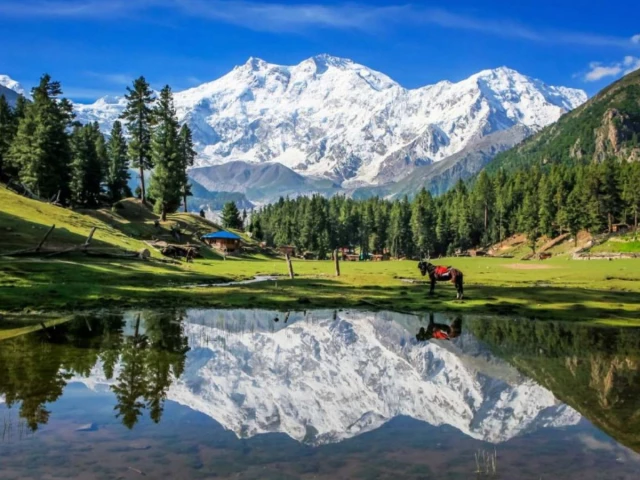The Gilgit-Baltistan has the potential to attract tourism in the region, the region become tourism destination to tourists after East Indian company came to subcontinent in 18th century. The British officer came to north for the research and spying purpose, because the region has important geographic location. Meanwhile other international tourists came into the region along with Britishers to monitor the climate.
In the meantime, their interest increased with the mountains of north and gradually, people went to the mountain’s sites, basecamps, and trekking towards glaciers. Thus, tourism activities started in the north region at that time currently Gilgit-Baltistan.
Further the tourism industry gradually developed in the Gilgit-Baltistan and after 2013 the tourism boom is started in Gilgit-Baltistan with the huge number of mass tourists came to the north and large infrastructure of hospitality industry were started to build. The tourism industry provides employment opportunities to local communities and creates a business market.
The potential of adventures tourism has also got famous in the region and attract hundreds of international mountaineers, climbers, and trekkers groups. Which provide economical assistance to the local economy, reports argue that in 2017 tourist contribute 300 million revenue in the regional economy. The region expecting more tourists into the region in coming years.
To accommodate the influx of tourist’s the development has been done unsustainably and unwanted, especially the areas that are fragile and ecologically sensitive and the development is in progress.
The unwanted development has taken place in the river beds and near to sensitive glaciers sites, lack of township planning leads towards deforestations, water contamination, artificially product incorporated in the construction, builds concrete forest around the tourism destinations and main city of Gilgit-Baltistan, Skardu, Gilgit, Karimabad, and Gahkuch are faces urban threats due to mushrooming.
The region already faces climate crisis, without contributing in gobble carbon emission because of its geographic location, the neighbored countries China and India are the world largest carbon emitter. And the mass tourism in the region triggers further environmental catastrophes in the sensitive ecology.
The tourism industry is becoming double-edged sword for Gilgit-Baltistan. It provides economic margins and uplifts the life standard of native communities, but the other hand poses significant environmental concerns to the highly fragile ecosystem.
The region Gilgit-Baltistan faces many environmental challenges by hospitality industry, pollutions, resources debilitation, overpopulated, destroyed natural landscapes, biological diversity habitat loss. The ecosystem disruption in the mountainous areas especially in the Hindu Kash, Himalayas, and Karakoram ranges are leading the GLOFs events, the land erosion process is faster than other mountains range around the globe.
In the recent years the Gilgit-Baltistan has face frequent GLOFs events and temperature raised, cause glaciers retreating, which means the glaciers lakes expand in the region. The tourism industry has the main carbon emitter in the region, due to its unsustainable expansion and activities. Ill transportation, green energy crisis are the main reasons.
Behind these all challenges and concerns has the policy gap and lacking of governance mechanism.
In Gilgit-Baltistan the government failed to provide good governance mechanism and service delivery, the region faces policy gaps badly there is no effective polices on ground that address the challenges. Thus, no governance mechanism, the local governments are missing from more than one decade, there is no community engagement in the whole process and tourism activities.
The government should engage the native communities in policy formulation and provide awareness regarding environmental concerns that lead the communities take the ownership and act accordingly. Another major factor that needs to address is awareness and sensitizations among the administrative structure regarding the sensitive of the ecosystem and how to act and policy implementation in the locality.
The well-developed countries have facing challenges of environmental degradation by mass tourism, and express protesting against tourism and been inti-tourist violences in well off and educated communities.
The communities argues that the tourism is diluting the diversity of culture and history. This will happen in the most educated societies. When it’s come to Gilgit-Baltistan the region is less educated, less developed and contain highly fragile ecology with the most vulnerable communities, so it can be inferred from this how uncontrol tourism impact the region.
Gilgit-Baltistan is most accessible region for domestic mass tourists, put pressure on the nature resources and degrade the environment. Requires robust policy and strategies to control mass tourism according the caring capacity of the region, and allow high end tourists that spend maximum and left minimum footprints.
The development should be controlling that ecofriendly material should be used, match with local architecture, and the environmental Impact Assessments should be compulsory for the development along with NOCs regulatory bodies, that the ecotourism practices should be incorporated in the hospitality entities.
In addition, CNN travel staff has included Gilgit-Baltistan as a top 25 five destinations around the globe to worthy visits in 2025. Obviously, it’s a landmark for tourism industry in the region.
But the hospitality sectors should be regulated as per the native environmental conditions.
The hospitality industry creates environmental concerns and pose pressures on resources of the region without any economic support to local economy, need to impose taxes on hospitality sectors and tourism markets, the revenue will be utilized within the region to support local communities’ wellbeing and sustainable development of Gilgit-Baltistan. It will overcome the dependency of the region to federal government.
Furthermore, the step towards sustainability of the ecology and reduction in environmental degrading, community awareness and engagements of all stakeholder in policy consensus, subject of tourism and environment should be incorporate in curricula.
Effective policies and governance mechanism should be implemented in the Gilgit-Baltistan to regulate the tourism industry and its footprints efficiently. Ecofriendly practices incorporate in the tourism sector as well in government structure to reduce environmental degradation.



COMMENTS (1)
Comments are moderated and generally will be posted if they are on-topic and not abusive.
For more information, please see our Comments FAQ